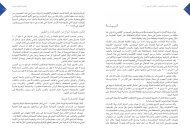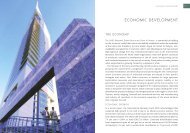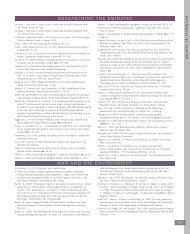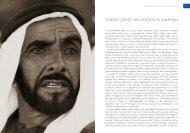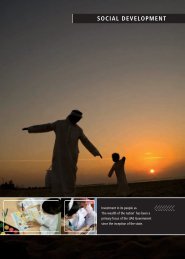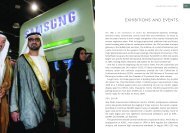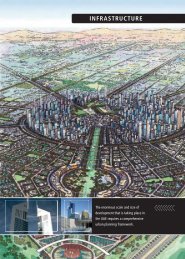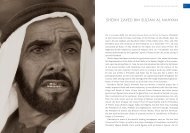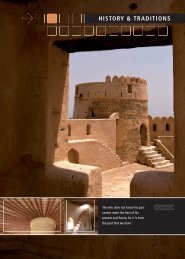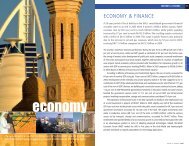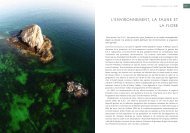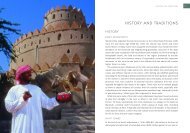ENVIRONMENT AND WILDLIFE - UAE Interact
ENVIRONMENT AND WILDLIFE - UAE Interact
ENVIRONMENT AND WILDLIFE - UAE Interact
You also want an ePaper? Increase the reach of your titles
YUMPU automatically turns print PDFs into web optimized ePapers that Google loves.
<strong>ENVIRONMENT</strong> <strong>AND</strong> <strong>WILDLIFE</strong>287<strong>ENVIRONMENT</strong> <strong>AND</strong> <strong>WILDLIFE</strong>‘This year, the <strong>UAE</strong> lost a founding father and unique leader. The world lost a greatsupporter for conservation with a passion for the environment that was beyondcompare.’THE REMARKABLE <strong>ENVIRONMENT</strong>AL LEGACY left behind by the late Sheikh Zayed binSultan Al Nahyan continues to shape the running of the <strong>UAE</strong>. Environmentalresponsibility now underpins almost all relevant decision-making processes ona day-to-day basis. Sustainable development, greening of the landscape and thepropagation of endangered species were special interests of a man ahead of histime. It is remarkable to realise that hunting with guns has now been banned in the<strong>UAE</strong> for over 25 years, this action having been taken because it was considered bythe late President as an ‘outright attack on wildlife’. The Sheikh Zayed FalconRelease Programme, now in its eleventh year, saw more birds released back tothe wild after the winter hunting season; yet another of his personal initiativesin the sustainable utilisation of wildlife. Almost 1000 individual falcons have beenreleased under this programme. Last, but not least, the island sanctuary of Sir BaniYas, held especially dear by Sheikh Zayed, continues to house endangered speciesof ungulate from Arabia, as well as from Africa, and has proven to be aninvaluable living repository of certain gravely-threatened species, including Arabiantahr, addax and Arabian and scimitar-horned oryx, all of which may be used infuture re-introduction programmes.In recognition of his sustained and far-sighted efforts, the late President wasposthumously recognised in 2005 with a ‘Champion of the Earth’ award by theUnited Nations Environment Programme (UNEP).Significantly, but almost passing unnoticed, the <strong>UAE</strong> ratified the Kyoto Protocolin January 2005 and has set itself targets for the progressive reduction of domesticcarbon emissions, as well as investigating innovative ways of cutting down onand disposing of all greenhouse gases. In a directly-related event hosted by AbuDhabi, the Environment 2005 International Exhibition and Conference, held inthe capital in February 2005, provided a forum for the discussion of options fordeveloping nationally sustainable transportation alternatives and reducing harmfulemissions. In a pilot study, the Abu Dhabi National Oil Company (ADNOC) hasfitted out some of its filling stations with natural gas facilities in trials for carsequipped to run on both this and petrol.
288UNITED ARAB EMIRATES YEARBOOK 2006<strong>ENVIRONMENT</strong> <strong>AND</strong> <strong>WILDLIFE</strong>289Finally, right under our feet, a new species of snake was described from themountains of <strong>UAE</strong> in 2004, the type specimen having being collected from WadiSiji near Masafi, Fujairah. Research overseas on museum specimens found thoseto have been taken from <strong>UAE</strong> and northern Oman to belong to a new taxon,now named the Oman saw-scaled viper Echis omanensis, and not the Burton’ssaw-scaled viper E. coloratus as was originally thought. However, it is necessaryto count and examine the shape of the gular scales under the reluctant viper’shead to tell the species apart, so fieldworkers can be forgiven for having missedthe difference!More significantly, in August 2005 honey badgers were confirmed in the <strong>UAE</strong> forthe first time, near Ruwais (three specimens: one dead, one seen, and one capturedand then released back where it was found). Yet another indication of how muchwork remains to be done in researching the natural history of the Emirates.EADThe Environment Agency – Abu Dhabi (EAD) (see box), formerly known as theEnvironmental Research & Wildlife Development Agency (ERWDA), is thecompetent authority in Abu Dhabi for environment and wildlife-related issuesin the emirate, ensuring environmental legislation is adhered to, and remainscommitted to the prevention of breaches of environmental standards, refusingpermits for the commencement of projects falling below the line. Follow-upinspections are made routinely, and projects, whether private or governmental,can be halted until any infringements are rectified. Existing facilities are alsorequired to meet new environmental standards and limits by upgrading accordingly.Targeted in particular are emissions and discharges, and waste production andmethods of disposal. Companies are being encouraged to implement environmentmanagement systems for their facilities as a pre-requisite for permit renewals.A symposium on ‘Integrated Coastal Zone Management in the <strong>UAE</strong>’ was hostedby EAD in Abu Dhabi over four days in June 2005. The five main themes of theforum were integrated coastal and marine management planning, natural resourceconservation, legal instrumentation, governance and institutional arrangementsand capacity building, with framework recommendations being produced atthe conclusion of a concurrent two-day workshop. A call was made for federallegislation to be enacted toward the institution of ICZM nationally.Among the many EAD projects currently under way are ongoing fish stockassessments and landing surveys (see Fisheries section), sail-fish tagging,conservation of dugong and sea turtles, research into mangrove ecosystems, soilsurvey and water resource management, and perennial educational programmes.These all form part of EAD’s five-year, 2003/07, strategic environmental actionplan for Abu Dhabi Emirate. The agency’s Environmental Awareness andEducation Division deserves special mention, having won several prizes andawards for its recently-produced public awareness and educational materials. Filmpresentations produced by the division continue to prove especially popular. Theagency is currently focusing on formulation of its 2005/10 environmentalstrategy, which is set to be substantially re-oriented toward the establishment ofsustainable development. Over-fishing of certain demersal species continues tobe addressed and fishery management options are being evaluated to guaranteestock recovery. The gravity of this problem is understood at all levels ofgovernment and a number of initiatives, with legal backing, have been taken withregard to permitted catching methods, net mesh size and close seasons. Fishingwith drift nets, (hayali) has been banned for the past five years, for example, withencircling nets (halaaq) now being used as an acceptable alternative method.A review has recently been conducted of amenity and agro-forestry projectsin Abu Dhabi Emirate, with improved soil and water conservation measuresbeing held to be of paramount importance in the future management of theseareas. Their value for wildlife, a variety of commercial products, such as honey,and recreational pursuits is also being enhanced.The Abu Dhabi Global Environment Data Initiative (AGEDI) received a fillip withincreased funding being made available in 2005. Launched at the World Summitin Johannesburg, South Africa, in 2002, by ERWDA, in association with UNEP,AGEDI has the goal of implementing the environmental data provisions of Agenda21 as well as the United Nations’ Millennium Development goal at national,regional and global levels. A memorandum of understanding was signed withthe <strong>UAE</strong> University to promote cooperation in environmental research and humanresources development and to assist in the implementation of AGEDI.A workshop bringing together stakeholders from throughout Abu Dhabi, includingboth government ministries and agencies and non-governmental organisations,was held in June to plan for the preparation of a baseline report upon which thesub-national AGEDI programme will be based.Dubai’s Ra’s Al Khor Wildlife Sanctuary saw the inauguration of a number ofbird hides this year at this ever-popular birdwatching venue, allowing close-upviews of feeding flamingos and a host of other waterbird species, many longdistancemigrants for which this stopover and wintering site is vital to their survival.Ra’s al-Khor has been a protected area since 1985.The Dubai Desert Conservation Reserve, of 225 square kilometres, 5 per centof the land area of the emirate, is managed and run as a national park, carefullyzoned for wildlife but with a luxury resort, Al Maha, operated with eco-tourismand traditional heritage particularly in mind.A four-day Conservation Workshop, the sixth in this now annual event, washeld at the Sharjah Desert Park in February 2005 and focused primarily on theregion’s larger birds of prey, particularly eagles and vultures, and on canids andfreshwater invertebrate populations. Data collated and reviewed during this
290UNITED ARAB EMIRATES YEARBOOK 2006meeting has been provided to the World Conservation Union (IUCN) for inclusionin its Red Lists and Red Data books. Progress with captive breeding and researchinto surviving wild Arabian tahr and Arabian leopard populations was also outlinedduring the internationally-attended gathering.The Breeding Centre for Endangered Arabian Wildlife, based at the Desert Park,continues its programme of captive breeding and research on numerous taxa,from invertebrates, fishes and reptiles to the undoubted flagship, and, much therarest and perhaps the greatest challenge of them all, the Arabian leopard.A Memorandum of Understanding (MOU) was signed between Sharjah’sEnvironment and Protected Areas Authority (EPAA) and the Abu Dhabi-basedEmirates Heritage Club (EHC). The two bodies will collaborate on various issues,including the second phase of the <strong>UAE</strong> Marine Atlas (see later review).Also in Sharjah, the Al Wasit lagoons (formerly known as Ramtha lake), identifiedin 1994 as an ‘Important Bird Area’ by the international non-governmentalorganisation Birdlife International, is set to become a showpiece wetland reserve.The area boasts a bird checklist of just under 200 species, including severalseen here for the first time in the <strong>UAE</strong>. This project, devised by Sharjah RulerHH Dr Sheikh Sultan bin Mohammed Al Qasimi, has been welcomed by residentand visiting naturalists alike, and a television documentary is being produced ofprogress at the site.WWF–<strong>UAE</strong>Abu Dhabi-based Dolphin Energy Limited, in a demonstration of its environmentalcommitment to the region, announced a US$500,000 three-year sponsorshipdeal of a WWF/ERWDA study to produce a conservation action plan for coralreef habitats in the Arabian Gulf. This is currently under way in collaborationwith the Supreme Council for the Environment and Natural Reserves, (SCENR)in Qatar. (Dolphin Energy has a mandate to construct a 400-kilometre gas pipelinefrom Qatar to the <strong>UAE</strong>). At the conclusion of the study, in 2006, a coral atlas,identification guide and strategy document will all be produced.WWF has also assisted the Dubai Municipality in the preparation of educationalmaterial for the new bird hides and visitor centre at Ra’s al Khor Wildlife Sanctuary,Dubai. WWF–EWS (Emirates Wildlife Society) and EAD have continued to trainstaff involved in enforcement of CITES regulations (see below) and also produceand disseminate related public awareness materials.CITESA short-lived Convention of International Trade in Endangered Species (CITES)trade suspension at the end of 2001, swiftly lifted following intensive efforts by<strong>UAE</strong> authorities to take control of the situation regarding illegally-imported wildlifeand wildlife products, has resulted in closer scrutiny by enforcement agencies to
292UNITED ARAB EMIRATES YEARBOOK 2006<strong>ENVIRONMENT</strong> <strong>AND</strong> <strong>WILDLIFE</strong>293detect illicit imports, exports and re-exports. The Geneva-based CITES Secretariatreported in July 2005 that the <strong>UAE</strong> now qualified, along with certain Westerncountries, for the top level ‘Category 1’ status, which reflects on the nationallegislation brought into effect to implement CITES regulations. The <strong>UAE</strong> issuedfederal legislation (Federal Law No. 11 for 2002) to regulate and control internationaltrade in wildlife.In one recent breach of the terms of the convention, shahtoosh shawls andscarves, made from the under-fur of the endangered Tibetan chiru, and with astreet value of nearly US$150,000, were confiscated during a series of raids byMunicipality officials on commercial premises in Dubai. A number of CITESlistedspecies of primate and reptile have also been recovered from pet souqsin the country, while, in the battle against the illegal and highly lucrative trade incaviar, many supermarkets and hotels are cooperating with authorities to ensureonly licit supplies are offered for sale. When discovered, caviar lacking appropriatedocumentation has been confiscated.The CITES Secretariat convened a consultative meeting in Abu Dhabi in summer2004, concentrating its efforts on implementation of the terms of the conventionand on ways of reducing the illegal trade in wild-bred falcons, at the same timeas facilitating movement for hunting purposes of legitimately held birds. Over40 delegates representing 18 countries attended, including most of the regionalrange states of houbara and saker falcon, as well as representatives from countriesengaged in captive-breeding of falcons for falconry. In an ongoing domesticinitiative, over 800 falcons held in the <strong>UAE</strong> have now been issued with ‘passports’to permit them to be taken on overseas hunting trips.OTHERBroadcasting on television of Arabia’s Cycle of Life, a dozen half-hour programmesfeaturing wildlife and conservation issues in the region, investigating bothmarine and terrestrial environments, and the first series of its kind produced inthe <strong>UAE</strong>, at Dubai Media City, commenced in January 2005.Several overseas researchers have found a favourable reception in the <strong>UAE</strong> inpursuit of their academic interests, including studies by the University of Bathinto the breeding biology of Kentish plovers at Abu Dhabi’s Al Wathba protectedarea; Thomas Wilmes, co-discoverer of the Leptien’s spiny-tailed lizard, calledin to assist in their relocation programme at Abu Dhabi International Airport(see box) and world authority on ants, Dr Cedric Collingwood, whose visitresulted in the identification of three new species for Arabia from ERWDA’s ownarthropod collection. An eclectic mix of scientific papers has been published,covering everything from lizard tracks in carbonate tidal flats and the results ofsailfish tagging to the distribution of heavy metals in marine bivalves and theabundance and conservation status of dugongs in the lower Gulf.NEW HOME FOR DHUBSThe spiny-tailed lizard or ‘dhub’, of whichtwo species are present in the <strong>UAE</strong>, theEgyptian spiny-tailed lizard, Uromastyxaegyptia microlepis, and Leptien’s spinytailedlizard, Uromastyx leptieni, haverecently come under increasing pressurefrom development. The two species, bothprotected, are very similar, and Leptien’sspiny-tailed lizard was only recognised asbeing a distinct species in 2000. It isendemic to the Emirates (meaning that itis not found anywhere else), and its rangeis not yet fully known.As a result of an environmental impactstudy carried out in early 2005, it becameknown that a large colony of Leptien’sspiny-tailed lizards lived in the desert areaproposed for expansion of the Abu DhabiInternational Airport, quite literally in thepath of the new runway. This showed that this species was distributed over amuch larger area than had previously been recognised.On instructions from the Supervision Committee for the new Abu DhabiInternational Airport (SCADIA) the project management consultants set to workto capture the dhubs on the site, so that they could be re-located away from theplanned development.The services of a resident ecologist were engaged and he, along with EADand a small army of volunteers, including one of the scientists who hadoriginally identified Leptien’s spiny-tailed lizard as a new species, set aboutcatching all of the dhubs on site; the sight and smell of traps baited with watermelon and carrots proving irresistible to these harmless vegetarians in the heatof summer. In all, around 200 animals were trapped.For the translocation, new suitable localities had first to be found. To thisend, a number of radio-tagged individuals were released in the safety of adesert oilfield and their progress followed.Later EAD arranged for most of the other animals to be released nearRemah, between Abu Dhabi and Al Ain, where other individuals of the samespecies were already known to be present. It is also hoped that some will bereintroduced back into protected areas within the new airport, oncepreliminary construction work has been completed.This is the first time that a re-location exercise of this type has been carriedout in the Emirates. Much has been learned from the exercise, in terms of howto catch the animals, how to keep them temporarily in captivity and on thetechniques that must be followed for re-location programmes and theappropriate follow-up.
294 UNITED ARAB EMIRATES YEARBOOK 2006<strong>ENVIRONMENT</strong> <strong>AND</strong> <strong>WILDLIFE</strong> 295SPECIAL STUDIESNATURAL HISTORY OF JEBEL HAFITA recent study was undertaken of the naturalhistory, geology and archaeology of AbuDhabi’s only true mountain, Jebel Hafit, bythe Emirates Natural History Group (ENHG)and Al Ain Natural History Group).The natural history included comprehensivesurveys of the flora and vegetation,arthropods, reptiles, mammals, birds, fossiland existing live, colourless cave fauna and,only recently discovered, clam shrimps. Eachspecialist was invited to write a chapter forthe book, Jebel Hafit: A Natural History,(reviewed in this Yearbook) publication ofwhich was sponsored by the Abu DhabiCompany for Onshore Oil Operations(ADCO). The mountain was found still toharbour the endangered Arabian tahr(Hemitragus jayakari), albeit in smallnumbers, as well as, amongst many others,giant skipper butterflies, an unidentifiedPierrot butterfly possibly new to science, anumber of extremely-localised species ofplant, and several caves holding regionallyimportant bat nurseries and hibernacula.On account of its remarkable wildlife,some of it to be found nowhere else in the<strong>UAE</strong>, Jebel Hafit is expected to become anational park in the near future.MARINE ATLAS OF ABU DHABIMarking the culmination of several years ofendeavour, the Marine Atlas of Abu Dhabi waslaunched by the Emirates Heritage Club(EHC) early in 2005. Research by theCommission of Environmental Research, partof EHC, was conducted with acknowledgedinternational experts from their respectivefields, covering separate faunal groups andhabitats from invertebrates, fish and birds toturtles, dolphins and dugongs, and mangrovesand seagrasses to corals and marine algae.Archaeology in the coastal zone and offshoreislands was also covered. Training of nationalsformed a simultaneous part of the field surveyprogramme, which itself commenced in1999. All of the assembled experts, most ofwhom knew Abu Dhabi well already, gave uptheir time voluntarily for the duration of theirrespective field studies and for subsequentanalysis and reporting.Publication of the results was a massiveundertaking and this is reflected in the size ofthe book. Each chapter is accompanied byone or more fold-out maps showing key areasof each particular habitat, for example, turtlenesting sites, the distribution of dugongs, orpresence of seabird colonies or shorebirdfeeding areas. It is envisaged that the resultsobtained and documented here, for the firsttime in a single volume, will facilitatesustainable development in Abu DhabiEmirate. Reviews of the atlas to date have allbeen favourable.BREEDING BIRDS OF THEUNITED ARAB EMIRATESAn Arabic edition of Breeding Birds of theUnited Arab Emirates, first published inEnglish in 1994, was released by EAD.Substantially updated from that earlier work,some 140 different species are described inthis large-format 240-page book. It is lavishlyillustrated, with colour photographs of almostall of those species described. Publicationwas made possible by sponsorship fromDolphin Energy, Total and OccidentalPetroleum. A second, revised, English edition,ten years on from the original book, isscheduled for publication later in the year.
296 UNITED ARAB EMIRATES YEARBOOK 2006<strong>ENVIRONMENT</strong> <strong>AND</strong> <strong>WILDLIFE</strong> 297<strong>ENVIRONMENT</strong> AGENCY – ABU DHABI (EAD)In July, <strong>UAE</strong> President HH Sheikh Khalifabin Zayed Al Nahyan passed Law No. 16for 2005 on the restructuring andre-naming of the competent authorityfor the environment in Abu Dhabi.The former authority, EnvironmentalResearch and Wildlife DevelopmentAgency (ERWDA), is now known as theEnvironment Agency – Abu Dhabi (EAD).Law No. 16 of 2005 states that EADwill remain an independent entity withfull capacity and financial and administrative independence. It will be chairedby the Crown Prince of Abu Dhabi, Sheikh Mohammed bin Zayed Al Nahyan,and will remain the responsible authority for environmental and wildlife issuesin the Emirate of Abu Dhabi. The law stipulates that all governmentdepartments and agencies are required to coordinate and cooperate with EADon issues relating to research or study or other activity that concerns theenvironment and wildlife.The law further states that the Minister of Justice can, in collaboration withthe Chairman or Deputy Chairman of EAD’s Board of Directors, appoint someagency staff members as judicial enforcement officers. These officers will beauthorised to inspect projects to ensure they comply with federal and locallaws and regulations. Any breach of law would be referred to the relevantjudicial authorities for prosecution. Moreover, agency inspection officers areauthorised to stop the development of any project or activity, or ban the use ofany equipment or materials found to be hazardous to the health and safety ofhumans and/or the environment.The law further states that EAD’s approval is required at all times prior to theissuing of regulations, policies and decrees that relate directly to environmentaland wildlife affairs. Any violators will be held responsible and accountable fortheir actions and may face imprisonment and/or strict fines of not less thanDh5,000 (US$1400), as well as confiscation of their hazardous equipment ormaterial. Furthermore, the relevant court may order the violator to remedy thedamage done to the environment within a timeframe to be set by the agency;upon which failure to do so would result in EAD acting on the court’s order atthe violator’s expense. The new law also stipulates that EAD’s mission willinclude working towards achieving sustainable development through itsenvironmental work and promotion of environmental awareness.Amongst the objectives specified for EAD by the 22 articles of the new law arethe following:To conduct studies, scientific research and comprehensive surveys of theenvironment and wildlife in order to prepare strategies and priorities; to assesswater and land resources in order to propose the most appropriate use ofthese resources; to assess the impact of industrial gases and household airpollutants on the environment and wildlife and recommend solutions for airpollution problems.To evaluate the treatment of household sewage, industrial liquid wastes and oilwastes, and recommend the establishment of projects to treat and controlthese liquid wastes; to evaluate the operation of recycling programmes forhousehold and solid wastes, assess their impact on the environment andintroduce new solutions, and to evaluate the effect of chemicals used inagriculture on the environment and propose projects to control their use in theEmirate of Abu Dhabi.To evaluate the effect of existing and future industrial projects in Abu Dhabi, incoordination with the Federal Environment Agency (FEA) and other concernedbodies, and to plan, develop and implement a balanced environmentalstrategy for infrastructural, industrial, agricultural and economic projectswithin the emirate.To evaluate the impact of hunting and fishing, recreation and leisure activitieson wildlife in the Emirate of Abu Dhabi and to recommend management plansand establish protected zones for wildlife.To establish and run parks and protected areas, implement rules andregulations to protect these areas, establish specialised centres for the care,study and breeding of endangered species, and rehabilitate animals for release.To establish specialised centres for environmental studies and scientificresearch.To coordinate and cooperate with government bodies, scientificestablishments, and research centres within the Emirate of Abu Dhabi andabroad and to recruit and train qualified national staff capable of planning andimplementing strategies to protect the environment and wildlife.To provide the public and private sector with information related to theenvironment and wildlife and to enhance public awareness on the importanceof protecting and restoring the environment and wildlife.
298 UNITED ARAB EMIRATES YEARBOOK 2006METEORITESScientific research in the UnitedArab Emirates took a new stepforward early in 2005, venturingmillions of years and millions ofkilometres away, with the discoveryof the first two meteorites everrecorded in the country.Both of the meteorites werefound in the south-eastern desertregions of Abu Dhabi in Januaryand February, during fieldworkbeing carried out by the Abu Dhabi Islands Archaeological Survey (ADIAS) incollaboration with the Archaeology Unit of Britain’s Birmingham Universityand the locally-based Emirates Natural History Group. Both have been shownto <strong>UAE</strong> President HH Sheikh Khalifa bin Zayed Al Nahyan, who has thankedthe finders, and has encouraged them to carry out further work.The meteorites were sent for examination to the Institute of Geology andMineralogy at Germany’s University of Cologne, one of the world’s top centresfor the study of exoterrestrial objects (or objects that come from outer space).The first to be found, and the smallest of the two, weighed 155 grams, butproved to be the most interesting in scientific terms. According to ProfessorHerbert Palme, the Director of the Institute, it is a ureilite, of which only 110have been recorded from among the more than 16,000 meteorites that havebeen scientifically studied from around the world.‘Ureilites are carbon-bearing ultramafic rocks composed of olivine andpyroxen, with some interstitial material,’ Palme reported. Many, including the<strong>UAE</strong> one, contain tiny diamonds, up to 0.1 millimetres in diameter. Thesewere probably caused as a result of collisions in space with other meteorites.’The second meteorite, weighing over 2 kilograms, is of a much more commontype, known as chondrites.Details of the two meteorites have been submitted by the University ofCologne to the Meteoritical Society, the world body responsible for registeringmeteorites, while small samples of each have been kept in the mineralogicalmuseum of the Cologne Institute. The two <strong>UAE</strong> meteorites will later go ondisplay in Abu Dhabi.Several meteorites have already been recorded from Oman, where theGovernment has introduced legislation to prevent illegal private collecting, Anumber of visitors to the country were arrested in early 2005 for searching formeteorites without a licence.



